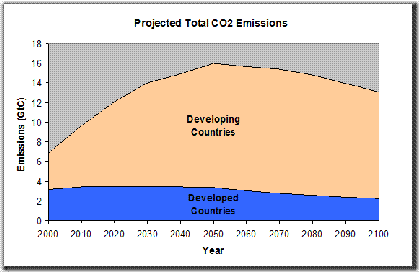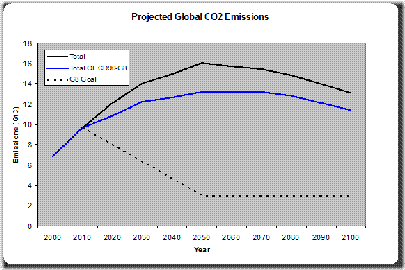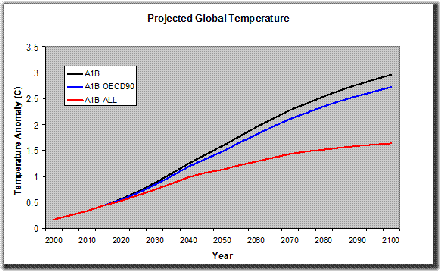The G-8 Countries Climate Agreement: A Lot for A Little
By Chip Knappenberger -- July 15, 2009At the G8 summit held in L’Aquila Italy last week, the G8 nations came up with a climate master plan aimed at keeping the total rise in global temperatures (above pre-industrial conditions) at a value of 2ºC or less. A cursory reading of the plan makes it seem as if the G8 nation’s are reaching out to the rest of world by agreeing to take on the harshest emissions cuts themselves, leaving the world’s developing nations with only a bit of mop-up duty in order to make all the final numbers work out. The opposite is true.
A close look at how the plan must actually work reveals a great semantics play by the G8. They know that they alone do not hold the power to substantially alter the projected course of future global warming through their emissions reductions. The real power is held by the developing nations of the world that want to develop, not accede to the rich countries’ notion of environmental sustainability. And no silver bullets have emerged in recent decades to effectively substitute for fossil-fuel-driven development, just as a seminal Science article several years ago explained and warned (1).
In an effort to entice the developing world to think differently about the problem, the G8 countries have devised a plan to reduce global carbon dioxide emissions which makes it seem as if they (the G8) are going to do most of the work and, therefore, it wouldn’t seem too much to ask of the developing countries to just help out a little to achieve the ultimate goal of keeping the earth’s average temperature to within 2ºC of its pre-industrial value.
Here is how the G8 described the plan that came out of its meeting in Italy:
We recognise the broad scientific view that the increase in global average temperature above pre-industrial levels ought not to exceed 2°C. Because this global challenge can only be met by a global response, we reiterate our willingness to share with all countries the goal of achieving at least a 50% reduction of global emissions by 2050, recognising that this implies that global emissions need to peak as soon as possible and decline thereafter. As part of this, we also support a goal of developed countries reducing emissions of greenhouse gases in aggregate by 80% or more by 2050 compared to 1990 or more recent years. Consistent with this ambitious long-term objective, we will undertake robust aggregate and individual mid-term reductions, taking into account that baselines may vary and that efforts need to be comparable. Similarly, major emerging economies need to undertake quantifiable actions to collectively reduce emissions significantly below business-as-usual by a specified year.
Setting aside their notion that there exists a “broad scientific view that the increase in global average temperature above pre-industrial levels ought not to exceed 2°C,” let’s review what they are proposing: the G8 countries will reduce their emissions by the year 2050 to a level that is 80% below the 1990 emissions level and the rest of the world need only to make up the difference to get the total global emissions down to 50%.
At face value, this seems a pretty good offer put forth by the G8 to the still developing nations. If the G8 reduces their emission by 80%, how much can there be still left to be done to get the global total only down 50%?
Let’s take a look.
Figure 1 shows the projected carbon dioxide emissions as prescribed in the IPCC’s middle of the road future emissions scenario (A1B) for the OECD90 countries (which include the G8 countries and a few other developed countries) as well as for the rest of the world (primarily the “developing” countries). The big thing that jumps out is just how much quicker the CO2 emissions from the developing countries are projected to grow into the future as compared to the emissions from the developed countries. At the beginning of the century the proportion of total emissions was pretty evenly divided between developed and developing countries. By mid-century, it is projected that developing countries will produce nearly 4 times as many CO2 emissions as developed countries. This is logical as developed countries have already in place the energy production that they need to run their economies while the developing countries have a lot of room for energy expansion (and projections of a large population growth).
Figure 1. CO2 emissions as projected by the IPCC A1B (middle-of-the-road) emissions scenario.
Figure 2 shows what the G8 nations propose to do towards limiting their CO2 emissions as well as the impact that this effort (assuming all OECD90 countries do the same) on the projected total future global emissions. Remember, this represents an 80% reduction below 1990 level by 2050. I have also shown on Figure 2, the G8’s ultimate goal—a 50% reduction of total global emissions from 1990 levels.
Figure 2. Total global CO2 emissions as projected by the IPCC’s A1b scenario (solid black line); total projected global CO2 emissions if the world’s developed nations (OECD90) do what the G8 master plan requires of them (blue line); the CO2 emissions target proposed by the G8 (dotted black line).
Figure 2 clearly shows two things:
1) A whopping 80% reduction in G8 emissions goes only a small way towards achieving the G8’s goal of reducing global emissions by 50% by 2050, and thus
2) The world’s developing countries are left to shoulder the brunt of the burden.
It is thus hardly surprising that the G8’s offer was greeted rather coolly (to say the least) by representatives from the developing countries, among others.
As far as mitigating climate change goes, the G8 does have its sights set on the proper scope of the emissions reduction necessary to try to keep global average temperature from climbing more than 2ºC above pre-industrial levels. Figure 3 shows the projected temperatures (using a procedure similar to the one I described in an earlier post) resulting from the original A1B scenario, and the A1B scenario adjusted for the OECD90 portion of the G8 master plan, as well as the temperatures resulting from a completely successful adherence to the G8 plan in its entirety. The projected global temperature rise from 1990 to 2100 is reduced from 2.96ºC to 2.72ºC with only the actions of the world’s developed countries. Again, proof that the G8 promises a lot, but can only deliver a little.
To get a significant reduction in the projected global temperature change, the developing nations need to play along. If that happens according to the G8’s plan, then the projected temperature rise from 1900 to 2100 tops out at 1.64ºC. Add in the 0.5ºC to 0.6ºC of global temperature rise from the pre-industrial era to 1990 and the G8 climate goal seems within reach.
Figure 3. Projected global temperature rise, A1B (black); A1B with OECD90 countries cutting emissions to 80% below their 1990 level by 2050 (blue); total global emissions reduced to 50% below their 1990 level by 2050 (red).
So apparently the G8 have the climate aspects of the plan all figured out. Now they just need to figure out some way of actually achieving an 80% reduction of their own CO2 emissions (a near impossibility) and convincing the rest of the world to do the same (a virtual impossibility).
It is orders of magnitude easier for the G8 nations to reach this agreement than to actually pull it off. That applies also to the aspirational goal of Waxman-Markey (HR 2454): a 83% reduction by 2050. Reality, as they say, is real.
————————-
(1) Martin Hoffert et al., “Advanced Technology Paths to Global Climate Stability: Energy for a Greenhouse Planet,” Science, November 1, 2002, available here.



When you find that you are digging yourself into a hole, the first imperative is to STOP DIGGING. Then and only then does it make sense to begin filling in the hole.
If, as Dr. Romm screams from any rooftop he can scale, the “green technologies” are so much better and cheaper than the dirty old fossil-fueled facilities and equipment, wouldn’t it be wiser for the developing countries to begin implementing them now, rather than investing hundreds of billions of dollars in those dirty old fossil-fueled facilities and equipment with 40-60 year economic lives. One would think the developing economies are the least well prepared to invest vast sums in facilities and equipment which would have to be removed from service before the ends of their useful lives, resulting in a substantial economic dead loss. 🙂
The G8 may be more clever than you think. Perhaps they are pulling a Canute, and we are supposed to learn from this that leaders can’t control the tides? 🙂
Another great post. Thanks.
“If that happens according to the G8’s plan, then the projected temperature rise from 1900 to 2100 tops out at 1.64ºC. Add in the 0.5ºC to 0.6ºC of global temperature rise from the pre-industrial era to 1990 and the G8 climate goal seems within reach.”
———————-
Errr no, it would still be 10% above the no-more-than-2°C goal and the sky would still fall. Whatever the promises, Romm (Dr) will still be burning.
[…] Chip Knappenberger on the G8 Dealing with Climate Issues: http://www.masterresource.org/climate-science/the-g-8-countries-climate-agreement-a-lot-for-a-littl… […]